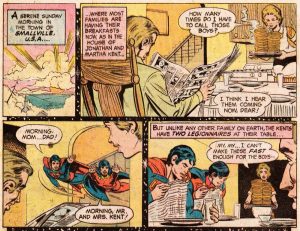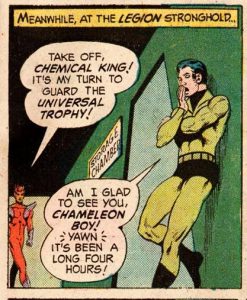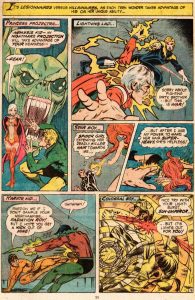 As soon as I posted yesterday’s review, WordPress kindly popped up “related posts” on my blog feed, and I realized that, in eulogizing the LSH back in 2013, I had covered a lot of the same territory I covered yesterday. Oh well, kids, old people tend to tell the same story over and over. Get used to it.
As soon as I posted yesterday’s review, WordPress kindly popped up “related posts” on my blog feed, and I realized that, in eulogizing the LSH back in 2013, I had covered a lot of the same territory I covered yesterday. Oh well, kids, old people tend to tell the same story over and over. Get used to it.
What was I saying? Oh, yeah, don’t you hate how old people tell the same story twice?
No, I was talking about Superboy #208, which I bought at a Highs—no, a 7-11—back in nineteen hundred and seventy five—on a Saturday, I’m pretty sure. Or a Wednesday. Okay, now I’ll stop sounding the way my kids tell me I sound, and get on with it.
Since I retold the same story yesterday, I’d like to expand today on my discovery of the super-heroic storytelling playground that was the Legion of Super-Heroes. First, I want to acknowledge that I’ve told conflicting stories. I said my first exposure to the Legion was in Superboy 207, and then I said it was seeing a house ad in my brother’s comics. It must have been the latter, but, as I recall buying that issue, I don’t remember having ever seen the group before. So I just don’t know. Anyway, issue 208…
Gotta love the GIANT format. Both Marvel and DC used it, but DC made a bigger deal out of it when they did. Marvel just either used the extra space for a bigger story, or included reprints in the back, with no indication on the cover as to their presence. DC featured ALL the included stories on the cover, and almost always used this grid design with pencils by the amazing Nick Cardy.
For 50 cents, you got a comic exactly twice the page-count of a standard comic. Back then, that was 64 pages, and the ads were kept to a dull roar, leaving 20 pages for a new story, and 28 pages for reprints, plus cool info-page features like this issue’s profile of the Legion of Substitute heroes. Today, when you buy a “Giant,” you get a hell of a lot less than twice the page count, and the price is largely based on the whim of someone in either production or marketing. I’ve paid 4.99, 5.99, even 7.99 for “giants,” and I don’t believe one of them contained 48 pages of story.
This format, especially those info pages, was perfect for the new reader. This was my second issue of the Legion. I hadn’t yet met all the characters. I didn’t know there was a substitute Legion, either. I thought it was a cool concept. No other team had that. (I would later learn that the JLA had “reserve” members, but not for a while.)
 The new story was a Cary Bates / Mike Grell masterpiece—probably my favorite of their run together. It begins idyllically in Smallville, Kansas, where the Jonathan Kents are having pancakes, served up by Ma Kent, who is obviously too young to have a teenaged son, so it’s a good thing she adopted. The panel where she’s carrying the tray always looked to me like she was kneeling on the countertop, but I eventually realized it was Grell showing, with her posture, that that’s a lotta damn pancakes. The boys fly in, and—
The new story was a Cary Bates / Mike Grell masterpiece—probably my favorite of their run together. It begins idyllically in Smallville, Kansas, where the Jonathan Kents are having pancakes, served up by Ma Kent, who is obviously too young to have a teenaged son, so it’s a good thing she adopted. The panel where she’s carrying the tray always looked to me like she was kneeling on the countertop, but I eventually realized it was Grell showing, with her posture, that that’s a lotta damn pancakes. The boys fly in, and—
Okay, wait! I know Superboy. I’ve watched him on TV. I’ve read his origin in the DC Collector’s Edition Superman special. His parents were white-haired when he was a baby! The Kents are old! Who are these brown-haired impostors, and who is the kid in red who looks like Superboy’s brother that’s flying to the breakfast table?
Oh, okay, his name is Mon-El, and he’s native to the 30th Century. (OK, no, he wasn’t, but it was a long story, and all the reader needed to know was that he didn’t live in 20th Century Kansas.) So is he Superboy’s brother? I know Superboy’s name is Kal-El…
A lot of reading comics back then was, for me, summed up in the phrase, “Just go with it.” Something happened that I couldn’t explain or didn’t expect, and I just told myself that the writers and artists were older and wiser than I, that I was safe in their hands, that they knew what they were doing, and I, someday, would figure it all out. More, it would be a lot of fun learning.
Wow. I just wrote myself an epiphany. I just described a relationship that I never had with any human being, except for a bunch of creators of comics, books and films. Creators I never knew, but somehow trusted with my delicate psyche. No person who actually knew me has ever earned that level of trust from me.
Huh. That says something about me. And this is why we blog, children, to figure out who in the hell we are.
And maybe that blind trust is why I felt so angry and betrayed when the gods of Comicdom did stupid shit like killing Aquaman’s son. That issue of Adventure Comics 452 is somewhere in my collection, riddled with creases because I first balled it up in my 12-year-old fists, and missing pages because I smoothed it out, cut out the last four pages, and wrote and drew my own ending. God, I wonder if I have those “revised” pages somewhere?
Boy, did I just digress. Sorry. Okay, so Superboy may or may not have a brother, and it would be years before I learned that DC had decided to make the Kents in Superboy’s series closed to the age of actual parents of teenagers, by having them hit by an alien ray or something.
 And that was Page 2. Gonna be a long read, kids. On page 3, I met Ultra-Boy, relaxing in the 30th Century with his parents. Then we jumped to the Legion Clubhouse. “Clubhouse?” It looks like a freakin’ airport! I want to build one of those in my backyard. Now. There’s an unattached line of dialogue: “Brainiac 5! The universal trophy has arrived!” Now, I missed the punctuation, and I thought Brainiac 5 was the name of the Universal Trophy. Brainiac was a robot, right? I quickly figured out that Brainiac 5 was the green kid I’d seen in the previous issue, and that he was accompanied by Saturn Girl, another new character for me, though I’d seen her on the cover of a previous issue.
And that was Page 2. Gonna be a long read, kids. On page 3, I met Ultra-Boy, relaxing in the 30th Century with his parents. Then we jumped to the Legion Clubhouse. “Clubhouse?” It looks like a freakin’ airport! I want to build one of those in my backyard. Now. There’s an unattached line of dialogue: “Brainiac 5! The universal trophy has arrived!” Now, I missed the punctuation, and I thought Brainiac 5 was the name of the Universal Trophy. Brainiac was a robot, right? I quickly figured out that Brainiac 5 was the green kid I’d seen in the previous issue, and that he was accompanied by Saturn Girl, another new character for me, though I’d seen her on the cover of a previous issue. Oops! Kinda sexist moment here—Brainy says they need to look their best on camera, and Saturn Girl is primping. Saturn Girl was never one to primp. Not to mention that Timber Wolf is behind her, and, damn, that boy must spend hours doing his hair every morning, so…
Oops! Kinda sexist moment here—Brainy says they need to look their best on camera, and Saturn Girl is primping. Saturn Girl was never one to primp. Not to mention that Timber Wolf is behind her, and, damn, that boy must spend hours doing his hair every morning, so…
As a robot news announcer speaks, Grell takes us on a brief tour of 30th Century Earth, showing futuristic delivery men in spandex, and people watching the broadcast in floating chairs. I meet Sun Boy, another new legionnaire, and then Pa Kent is pulling a gun on his son(s) and Superboy and Mon-El are beating the crap out of each other.
In Chapter Two of this story, we meet the Legion of Super-Villains. Makes sense, right? If there’s a Legion of Super-Heroes… Disregard the fact that it’s unlikely that a group would name themselves this, anymore than mutant terrorists would name themselves “The Brotherhood of Evil Mutants.” Now here’s where Bates and Grell really do it right: there are capsule bios of each villain, letting new readers know who they are. Since some of these characters haven’t appeared since the Legion’s original series years before, a re-introduction is needed. (Also, I’m pretty sure Sun Emperor, Sun Boy’s evil opposite, was cut from whole cloth for this story. Wikipedia says… A-ha! Took a little digging, but he was created in 1962 for a Superman’s Pal, Jimmy Olsen story. Apparently he was not seen again before this story appeared in 1975. So this was his first appearance in an actual Legion story.)
 Besides introducing readers in words, Grell introduces the character’s personalities in this quick intro. Just look at the way they’re sitting in their chairs: Lightning Lord clearly either needs to go to the bathroom, or has a very long pole inserted into his nether regions. Guy is uptight; Nemesis Kid is kicked back and displaying his junk. This guy is a douche; Spider-Girl is playing it more coy with her legs, but nonetheless going to seduction; Radiation Roy is hunched forward, either hard of hearing, too eager for action, or depressed because Spider-Girl is ignoring him. Any way you slice it, Roy is an unhappy guy.
Besides introducing readers in words, Grell introduces the character’s personalities in this quick intro. Just look at the way they’re sitting in their chairs: Lightning Lord clearly either needs to go to the bathroom, or has a very long pole inserted into his nether regions. Guy is uptight; Nemesis Kid is kicked back and displaying his junk. This guy is a douche; Spider-Girl is playing it more coy with her legs, but nonetheless going to seduction; Radiation Roy is hunched forward, either hard of hearing, too eager for action, or depressed because Spider-Girl is ignoring him. Any way you slice it, Roy is an unhappy guy.
 I meet poor, ill-fated Chemical King on the next page. He’s one of four Legionnaires created specifically so we could see them die (along with Shadow Lass, Quantum Queen and Reflecto.) When first introduced, he saw a lot of action. Here, in one of his final appearances, he’s granted two panels. It’s funny, Sun Boy as acting leader is so integral to this story that I felt like I’d known his character for years. The shared concern between him and Saturn Girl, revealed in this same issue to have once been leader of the group, is well-done.
I meet poor, ill-fated Chemical King on the next page. He’s one of four Legionnaires created specifically so we could see them die (along with Shadow Lass, Quantum Queen and Reflecto.) When first introduced, he saw a lot of action. Here, in one of his final appearances, he’s granted two panels. It’s funny, Sun Boy as acting leader is so integral to this story that I felt like I’d known his character for years. The shared concern between him and Saturn Girl, revealed in this same issue to have once been leader of the group, is well-done.
As the story climaxes, we meet Chameleon Chief, another duplicative villain, who has disguised himself as the Universal Trophy and gotten himself delivered to Legion HQ so that he can plant a booby-trapped trophy and wreak all manner of mayhem when it blows up.
Alas for the LSV, the plot is foiled, and five Legionnaires who had played no part in the story thus far raid the villains’ hideout and dispatch them. While it’s odd that the focus suddenly shifts to a new team, it makes sense that such a large group would dispatch a different group to handle the battle. And once again, knowing that there’s no time to intro these characters via the story, Bates does us the favor of telling us who each one is as they do their thing. Princess Projectra and Star Boy were new to me, and I had only seen Karate Kid in passing. I always thought it was sad, though, that Sun Boy didn’t get to confront Sun Emperor, as Lightning Lad got to defeat his brother Lightning Lord. Shadow Lass makes a very brief appearance at the end of the story, unnamed, making me think again that she was a supporting character, and not one of the heroes.
But overall the story does a great job by the new reader, and that’s a difference, I think, between comics when I was a kid and comics now. Writers and artists then knew that every comic book was someone’s first comic book; and while there was a learning curve, it was more tantalizing than overwhelming. Things like roll calls, explanatory character notes, and above all editor’s notes, which told the reader when key events of the past took place, all welcomed the newbie and made him feel like he was learning something. When there are editor’s notes in comics now, they’re pretty much there exclusively to entice readers to buy trade paperback collections.
I am at nearly 2,000 words, and haven’t even reviewed the reprint pages of this issue. Guess it’s time to call it a day.
